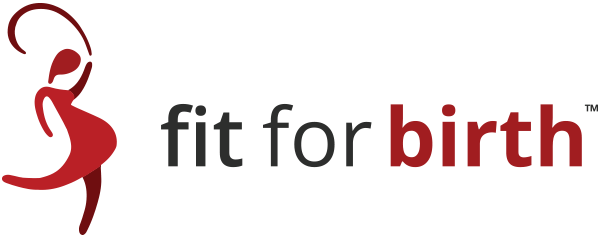Last Updated: 8/23/24
Diastasis recti (DR) is a common condition where the outer abdominal muscles separate during pregnancy, stretching the linea alba (LA) connective tissue beyond its normal length. It can persist long after childbirth, leaving many women with pain, as well as a bulge or “pooch.” While surgery is an option for severe cases, many seek non-surgical methods to manage and repair this condition.
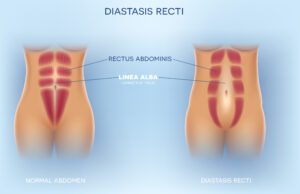
Diastasis Recti Before and After: Should You Take the Surgery Route?
Scientific research as well as case studies at Fit For Birth have demonstrated that some extreme cases of DR do need surgery, but it’s worth giving yourself a chance to heal your body without surgery first.
How long after childbirth can I heal my diastasis recti?
Healing your diastasis can happen at any age. However, there are 6 crucial elements for determining how long and how effective your permanent healing will be. Make sure you understand each, in order to determine whether or not you need surgery.

What are the 6 Crucial Elements for treating Diastasis Recti, Postpartum?
There are 6 Crucial Elements to consider when discussing Diastasis Recti (DR) with your clients. Each of these points are important because the overall goal that most clients are seeking is to look & feel better in their postpartum midsection. Sometimes what helps to achieve this goal is the technical healing of DR, but sometimes looking & feeling better is actually achieved by healing other factors that often get wrapped up as DR. Therefore, understanding how to differentiate these key points is absolutely critical for holistic healing.
ONE: Width – Although “width” (>20mm, or 2 fingers) is the measure used in research & by various professionals to diagnose DR, it is just one of several factors that affect the way that you or your client feels about your or her body. To be sure, if the width is large enough – say 5 fingers or more – surgery becomes almost necessary for some semblance of proper function. It’s like any tendon or ligament tear: many people are able to get along just fine with mild or moderate tears, but a “major” or “complete” tear will most often necessitate medical intervention.
TWO: Integrity – Integrity refers to the firmness of the linea alba (LA). Although the size of the width typically correlates to the integrity, these are actually two distinct aspects of DR.
- On one hand, it is possible to have a relatively narrow width, but too much softness (lack of integrity).
- On the other hand, it’s also possible to have a rather wide gap, but a very firm integrity. (This is often the case when someone with DR properly trains her core & abdominals after the separation occurs.)
THREE: Function – Function is actually the most important physical factor when it comes to various associated symptoms of DR. Even if the gap is wider than before, having great – even excellent – core function is quite possible. This is exactly what Fit For Birth has helped clients to create for themselves since our inception. Function is very often the main culprit behind whether or not a postpartum woman appears to look “three months pregnant” even years after her last delivery.
- On one hand, a person with normal width can have terrible function, along with subsequent aches/pains, and even a lower abdominal pooch. Not using the correct “inner unit” core muscles will eventually lead to an unhealthy-looking midsection.
- On the other hand, a person with a relatively wide gap can have amazing function, few aches/pains, and also an outstandingly beautiful midsection. We help our client’s create this regularly using Fit For Birth training.
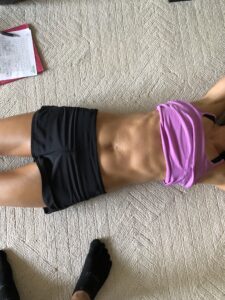
FOUR: Body Fat – The amount of fat that a woman holds over her midsection must be addressed in the DR discussion, because body fat affects the overall look of a postpartum tummy. There are some cases of “DR” that are no longer considered “problems” as soon as the excess body fat is shed. If excess body fat is not addressed as part of the DR conversation, then a complete resolution is far more vague. In this case, it comes down to addressing your client’s overall exercise and nutrition habits, as well as other lifestyle factors (like stress, circadian health, breathing, and toxic overloads). The client must be taught how to actually utilize body fat as fuel, not just sugars, and that often requires a massive health overhaul.
FIVE: Excess Skin – The same belly-expanding pressures that overstretch the LA collagen bands, causing DR, are the same pressures that can over-stretch the skin. It’s important to discuss this factor with your client since excess skin may contribute to the overall look and feel of postpartum DR. Tightening excess skin centers around promoting collagen production. The non-surgical options include topical, laser, radiofrequency, ultrasound and microneedling. Be sure that your client knows the difference between DR width, excess skin, and excess body fat. These are three independent factors, each weighing in on the overall look & feel of the midsection.
SIX: Mindset – Since one’s mindset has such profound effects on self-image as well as pain management, mindset is often the most important factor of all. For example, you may have a client with a very small gap, great integrity, and a 6-pack who simply does not like the change in their postpartum body. At the same time, you may have another client with quite a large DR, and more body fat than they’d prefer, but who absolutely loves their body because it represents who they have become through the birthing process, like a treasured “battle scar” of motherhood. After addressing width, integrity, function, body fat and excess skin, one question will still remain: “How do I feel about myself?” Helping your clients navigate this question is its own unique, and powerful, opportunity for you as a health coach.
Video (0:32): This client is 4 years postpartum (2 pregnancies). She trained for several months with Fit For Birth and developed such mastery over her muscles that she was literally able to close and open her DR “on cue.”
.
When is the best time to address diastasis?
The absolute best time to address diastasis is during pregnancy, intending to prevent it from forming in the first place. (Learning to use your Core Breathing is the foundation for how to do this.)
Once postpartum, if DR is already present, your first step toward healing is to begin working on your abdominal function through target abdominal exercises (item #3 of the 6 Critical Elements above) as soon as you become aware of your diastasis.
Video (0:24): This 36-week pregnant woman is learning to prevent Diastasis by establishing proper core function in the midst of traditionally difficult-to-do pregnancy exercises, like the plank.
Video (0:19): Applying proper core breathing mechanics to all activities of daily life is the key to both prevention and healing of Diastasis Recti. In this video, a 36-month pregnant woman feels just how big a difference it makes for her to rotate using her Core Breathing Belly Pump®. Consider that a person uses rotation all throughout the day as a part of nearly every movement, including when every step is taken, and you can see how impactful solid core mechanics can be. Moment-to-moment daily movements are how DR is either created, or prevented & healed altogether.
Can a diastasis recti be fixed without surgery?
Absolutely yes, in the majority of cases. Many women successfully heal diastasis recti through targeted exercises and lifestyle adjustments. The key is consistency and the right approach tailored to the severity of your diastasis, and taking into account the 6 Crucial Elements addressed above.
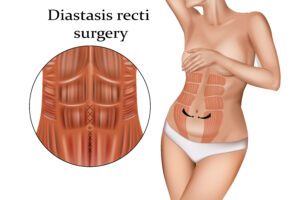
How long will it take to heal a diastasis recti?
The healing timeline for DR varies significantly depending on which of the 6 crucial elements are most in need, as well as your age and genetic makeup.
3 months: For most clients, enhancing function, width, and integrity with targeted exercises will show noticeable DR improvements in the first 3 months. Any pain related to DR should be reduced immediately within every exercise session. In fact, each exercise should be rated as to whether or not it improves, worsens, or appears to have no effect on your client’s pain, as well as the aesthetics of the DR gap.
1 Year: Addressing the corresponding body fat and excess skin will often require one year. This is the time-frame in which you will be able to determine whether or not a deeper sense of “complete healing” can take place without surgery.
If you or your client is unable to make satisfactory changes in function, width, integrity, body fat and skin in one year, surgery then becomes an option. Remember, if at any point DR-related symptoms, like pain, are making targeted exercise sessions difficult, referring to a qualified women’s physical therapist or Fit For Birth Diastasis and Core Consultant must take priority before continuing.
How to check a diastasis

To check yourself for DR, lie on your back with your knees bent and feet flat on the floor. Feel along your midline above and below your belly button, to get a sense for how your LA tissues feel in this relaxed position. Then, while still feeling your tissues above and below your navel, gently lift your head and shoulders off the floor as if performing a mini crunch.
Check for these three things:
- Is some portion of the LA significantly wider than in other areas (more than 2 finger width gap)?
- Is some portion of the LA significantly softer than in other areas?
- Is there a noticeable visual discrepancy from how you remember your tummy to look, like a vertical “coning” rising along your centerline?
Video (1:21): A FFB student is practicing checking DR in a 3-month postpartum client, and finds a gap that is about 3-finger width.
Video (1:22): A different student checks for DR in the same 3-month postpartum client as the previous video, but this time James describes how DR is connected to “core instability.”
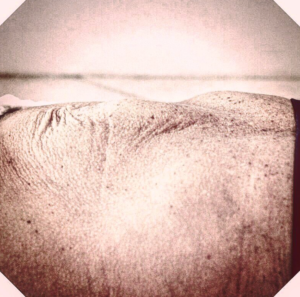
Posture improvements to help diastasis
Improving your posture can significantly affect the healing process of diastasis recti, sometimes in an immediate fashion. In our first filming of the Pre & Postnatal Diastasis and Core Consultant (PPDCC) course, WPT Pamela Downey, DPT, MSPT, demonstrated this with a participant in the course. After teaching the participant to keep her spine aligned, her chest open, her pelvis neutral, and her shoulders blades together, multiple symptoms of this participant’s DR disappeared on camera! Subsequent online course students have commented on this being one of their favorite parts of that filming.
Avoid slumping, which alters the intra-abdominal pressures within your ab muscles. And of course, strengthening your core helps maintain good posture and supports abdominal healing, in general.
Non-Surgical Cure for Umbilical Hernia and Diastasis
While umbilical hernias sometimes require surgical intervention, mild cases can be managed with targeted exercises aimed at strengthening abdominal and pelvic floor function, similar to how one would address function for DR. Engaging in a targeted exercise program can help reduce the hernia’s size along with the diastasis gap.
DR is an over-stretching of the centerline LA tissues, whereas a hernia is a complete puncture, or hole, in those tissues.
Need for surgical hernia repair can vary extraordinarily. On one hand, many people live with small hernias without it affecting their lives, nearly at all actually. These people often never feel that surgery is necessary. Some also have become accustomed to pushing bits of internal tissues “back inside” if ever they notice something coming through. On the other hand, however, a hernia can be extraordinarily painful, necessitating practically immediate surgical repair.
In the case of pregnancy & postpartum, the hernia that most often arises is called an umbilical hernia. This means that the connective tissue under & around the belly button may have a nearly complete puncture. These kinds of hernias aren’t typically painful, and often do not have contents pushing through the opening. Therefore, the “need” for surgical repair is not common.
Learning how to heal my diastasis recti through exercise
Engaging in exercises specifically designed to heal diastasis recti is crucial. This includes movements that strengthen the transverse abdominis (TVA) and pelvic floor (PF), which are the deepest layer of the core inner unit. And this needs to be done without further straining the separated muscles.
What few realize is that in order to train the TVA and PF effectively, one must first be able to properly activate the diaphragm (DPH) breathing muscles. The integrated use of these three muscles are going to provide the foundation for proper intra-abdominal pressure regulation that is required to (A) stop further micro-tearing of the LA, and (2) provide the environment for tissue repair and strengthening.
The term we use at Fit For Birth to describe proper connection between breathing and core is “core breathing.” You can find out more about the Core Breathing Belly Pump here.

Which exercises help me heal diastasis recti?
- First learn to diaphragmatically breathe. This means inhaling to fill the lateral ribs & lower back, which nearly always means learning to fill the belly first. For any clients who already have DR present, teach them to inhale to about 90-95% into the belly (100% into the lateral ribs and lower back), so as to avoid further micro-tearing the LA.
- Second, you can choose literally any exercise that does not promote micro-tearing in your client. This will be different for every client, but can include abdominal corseting, planks, crunches, oblique rotations, and more. If there is only one thing you get from this point, it must be: HOW the exercise is performed is far more important than which exercise is performed. Any client on any given day can use the exact same exercises to worsen or improve a DR. HOW to perform the exercises is the key. Avoid anything that causes a DR bulging or further pulling apart of the LA.
Video (0:43): In this video, Fit For Birth Head Coach, Clara, shows how to (1) Breathe diaphragmatically, (2) breathe into the lower back & pelvis, and (3) how to use your core breathing during sitting/standing, as well as tucking the pelvis.
5 Ways to Fix Diastasis Recti (Without Surgery)
- Targeted inner-core exercises: Specific exercises can help rebuild function of the abdominal muscles like the transverse abdominis (TVA). This inner-core “function” may include learning how to strengthen as well as relax these muscles. Strengthening may include activating the muscles via abdominal corsets and compressions. Relaxing may require adjusting a deeply ingrained habit of excessively “holding” the tummy in.
- Targeted pelvic floor exercises: Pelvic floor muscles constitute the bottom of the inner unit core muscles. They work in synergy with the TVA and the breathing muscles to create appropriate intra-abdominal pressure control, which is needed to make sure that the micro-tearing of diastasis does not occur any more. Proper balance in these muscles allow proper abdominal function. Like the TVA, they can be under-active or over-active, so determining which you are is the first step (an internal assessment with either a pelvic floor physical therapist or an external, mind-focused, assessment with a Fit For Birth Pre & Postnatal Diastasis and Core Consultant can help you get started). If you are under-active, you need to start activating these muscles during your exercises and activities of daily life. If you are over-active, you need to start relaxing these muscles “posturally”, as you move about life.
- Targeted diaphragm breathing exercises: The diaphragm (DPH) is the top of the inner-unit core complex. It is actually the main driver for how your PF and your TVA function moment-to-moment throughout the activities of life, so any talk of core function without discussing breathing is missing the foundational component. While it is true that inhaling too deeply into your belly – once you have diastasis – is not the best option, learning to integrate your “core breathing” into your activities of daily life is absolutely critical. I would even say it’s the most critical factor for healing diastasis. See, how your DPH reacts as you bend, walk, exercise, hold your kids, and more, is what establishes the rhythm – or lack thereof – of core pressure regulation that is needed to prevent further diastasis injury to the linea alba (LA) tissues. You need to learn to inhale into the belly, lateral ribs, and lower back for most of your 20,000 breaths you breathe each day. That is non-negotiable. This is what establishes the natural core shock absorption that prevents DR in the first place, and also sets the foundation for healing DR once the separation has already occurred.
- Modify daily activities: By point #4 here, it may be more obvious that how you do life – not just how you do exercise – makes the biggest impact on healing diastasis. What good is 1 hour of targeted exercise if the other 15 hours of the waking day are spent causing more DR micro-tears inside all your activities of daily life? You must intend to integrate your core breathing into your moment-to-moment existence, whenever you think to do so. Set a few daily reminders, if that’s helpful. One of the first steps is to start using your core breathing to initiate your movements. For instance, when standing up from sitting, remember to activate some version of core breathing as you rise.
- Find a professional: As human beings, our sedentary culture is taking a toll. I often tell clients that our school systems are already past the point of needing to include corrective exercise education as mandatory for every middle & high school. And, while each of us is intuitively and naturally inclined with special awareness and mastery over some set of skills, many of us do not have optimal physical body function as one of those skills. Scientific research studies have stated time and again that “an individualized approach” is more effective. If you can, get a reputable personal assessment that helps you truly understand your body. Do this for 3 months minimum, and 1 year preferably. Imagine what learning this fundamental skill may do for the next five or more decades of your life… It is a priceless investment, and one that will pay itself back every time you fix your own pain without needing to visit the doctor or take medicine. One of those options is to work with a Pre & Postnatal Diastasis and Core Consultant.
With dedication to a tailored exercise regimen and careful modification of daily activities, it is entirely possible to significantly improve or even completely heal diastasis recti without surgery. Prioritizing your core health postpartum can make a dramatic difference in your recovery and overall quality of life.
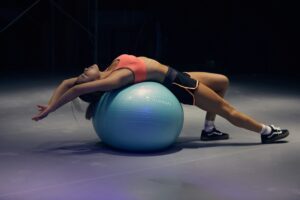
FAQs
Is it possible to correct diastasis recti without surgery? Yes, many cases of diastasis recti can be significantly improved or fully corrected without surgery through targeted exercises, particularly those that strengthen the core and pelvic floor.
What is the fastest way to fix diastasis recti? The fastest way to address diastasis recti is through a dedicated and consistent exercise program focused on core strengthening, along with guidance from a corrective exercise specialist, specialty trained women’s physical therapist, or diastasis & core consultant.
Can I get a flat tummy with diastasis recti? Achieving a flatter tummy is possible with diastasis recti through specialized core exercises and overall body conditioning, although results will vary based on the severity of the condition and individual body types.
Can you heal diastasis recti on your own? Yes, you can work on healing diastasis recti on your own by following an appropriate exercise regimen and lifestyle adjustments. However, consulting a diastasis exercise specialist for personalized guidance will ensure that you are using the right muscles for your unique muscle balance & alignment.
—————————–
If you would like fun guidance during your own pregnancy, postpartum, or as a fitness professional, please check out these Fit For Birth offerings:
- Pregnancy, Pre-conception & Postpartum:
- Fitness & Wellness Professionals:
—————————————————-
James Goodlatte is a Father, Holistic Health Coach, Corrective Exercise Practitioner, Speaker, Author, Professional Educator, and the founder of Fit For Birth. Since 2008, when he found out he would be a father, his passion for holistic wellness shifted to children and families. Today, he is a driving force in providing Continuing Education Credits for the pre and postnatal world, with Fit For Birth professionals in 52 countries. James is a contributing member of the First 1000 Days Initiative at the Global Wellness Institute, and longevity researcher & educator.
